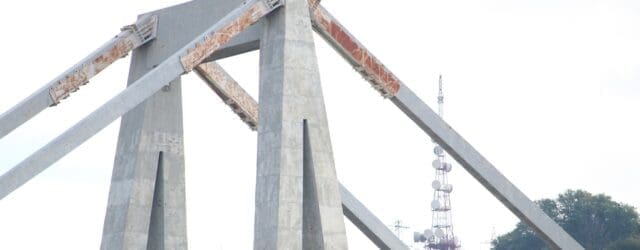The Genoa Bridge Collapse: How and Why?
October 2023The collapse of the Genoa bridge in Italy in 2018, that killed 43 people and left many hundreds homeless, sparked a critique of the inspection regime of bridges and highways in Italy and specifically, how privatised maintenance and passive state regulation ultimately resulted in the tragedy. It also prompted the UK to evaluate its inspection regime which differs quite significantly due to stricter regulations and government body oversight.
Background
The iconic Polcevera Bridge in Genoa, also known as the Morandi bridge, was built in 1967. On 14 August 2018, it collapsed during a storm resulting in the death of 43 people. This marked Italy’s worst ever road-bridge disaster.
The Polcevera Bridge formed a link in the main motorway between the South of France and Rome. The collapse had severe implications for the local economy. Debris from the incident blocked the railway line for weeks and residents who owned homes underneath the bridge were forced out.
The structural make up of the cable-stayed bridge comprised of prestressed concrete structures for the piers, decks and pylons and a hybrid system for the stays, constructed from steel cables reinforced with concrete.
Cause of collapse
Autostrade per I’Italia (“Autostrade”), the company in charge of the bridge, was deemed responsible for the collapse as they were in charge of the monitoring and safety of the bridge. In a 2011 report by Autostrade, the company had expressed concerns over the state of the bridge, citing that it had decayed due to heavy traffic and that a collapse within 10 years was possible.
Steel cables supported the road, however when exposed to atmospheric conditions, steel can rust. Italian engineering experts suggested that corrosion to the steel cables led to the collapse. Another potential cause was the use of concrete which also deteriorates quickly. Whilst the exact cause of the collapse remains unknown, investigations showed that the southeast cable on pylon 9 broke, creating a structural imbalance which triggered the collapse.
The prosecution
59 individuals went on trial. This included Autostrade, Spea Engineering, the engineering company that oversaw the inspection of the bridge and Italy’s transport and infrastructure ministry. At the time of the collapse, Autostrade and Spea were both subsidiaries of the holding company Antalia. Charges ranged from manslaughter to making false statements.
On 7 April 2023 a judge accepted a plea bargain of €30 million from Autostrade and its former maintenance unit Spea for the collapse of the bridge.
Inspection regime:
A key factor deemed to have contributed to the collapse was Autostrade’s allegedly poor inspection regime. The bridge had been plagued with structural issues since its construction in the late-1960s. This resulted in expensive maintenance. The prosecution at the trial argued that the defendants were aware of the risk of collapse but failed to act.
The collapse sparked a critique of the inspection regime in Italy, specifically how private bodies in charge of the inspection fell below an adequate standard. Indeed, Autostrade’s parent company also owned Spea, the maintenance and inspection company and thus, Autostrade were essentially self-regulated. Critics have termed this a deep systemic failing into how Italy privatised roadways and subsequently failed to ensure safety. The power imbalance between private companies and the state arguably resulted in inadequate state oversight. Experts say that when it comes to inspection arrangements, greater regulation of privatised bridges and highways is required by the government.
The inspection regime across Europe varies. In the UK, responsibility for maintaining the UK’s highway bridges falls under the National Highways (or devolved bodies). These bodies outline the rules for maintenance and the frequency of inspection. The UK utilises technologies such as drones, acoustic emission monitoring devices and real-time monitoring systems on large structures.
Additionally, in some circumstances local authorities or trusts are responsible for the maintenance and inspection of bridges. Inspections can be carried out by private companies who inspect on behalf of the authority responsible.
A key contrast between the inspection regime in the UK and the regime in Italy is that although private companies are used to carry out inspections in the UK, the standards and inspection requirements are specified by government bodies. Thus, there is a greater responsibility to meet those standards which are often set out in the concession contract.
The ‘Design Manual for Roads and Bridges’ dictates that bridges must undergo a general, visual inspection every two years and a close, principal inspection every six years. The Construction (Design and Management) Regulations 2015 also places duties on a range of parties, including designers, contractors and clients to ensure that construction works including the maintenance activities, are executed and designed to a high standard, using competent experts with adequate resources.
Having a vigorous monitoring process in place enabled the identification of potential risks associated with the Hammersmith Bridge. Initially built in 1887, it is one of the world’s oldest suspension bridges. Comprised of wood and wrought iron, with the suspension held in place by cast iron pedestals, it is known as a national landmark. However, in 2020 the bridge was fully closed on public safety grounds. Investigations showed micro-fractures in the cast iron pedestals which hold the weight of the bridge. Engineers discovered this was due to unchecked corrosion. In 2021, it was reopened to pedestrians and cyclists following an extensive investigation and the implementation of a temperature control monitoring system.
Hammersmith and Fulham’s engineers began working on the bridge on 28 February 2022 as part of a two-phase £8.9 million restoration project. Phase one focuses on the stabilisation of the bridge, specifically stabilising the micro-fractures in the cast iron pedals and replacing the Victorian bearings. Phase two relates to the completed restoration and opening of the bridge. Hammersmith and Fulham Council submitted the business case for the programme to the Department for Transport in December 2022. A procurement process is underway and 10 interested potential bidders have put themselves forward to carry out the full restoration project. It is anticipated that invitations to tender will be issued in 2024 with a contract award made by 2025.
Conclusion:
In essence, it seems that a key factor contributing to the tragic Polcevera bridge collapse was the privatisation of the maintenance and inspection of bridges in Italy, coupled with minimal state oversight. The tragedy is a timely reminder of the need for clarity and strict controls over standards where matters of life safety are concerned and where powers are devolved to private companies and a need to ensure those standards and controls are maintained. Whilst the current industry and government focus in the UK is on building safety following Grenfell, the exact same considerations arise for our infrastructure. It is a shame it takes tragedies of this scale for corrective action to take place
Download PDF








